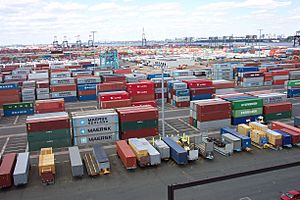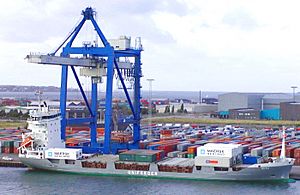Containerization facts for kids


Containerization is a smart way to move goods around the world. It uses special steel boxes called "shipping containers." These containers are all built to the same sizes. This means they can be easily loaded, stacked, and moved long distances. They can go from ships to rail trains and then to semi-trailer trucks without anyone needing to open them up. This system started after World War II. It made moving things much cheaper and helped international trade grow a lot.
Contents
History of Containers
Early Ways to Move Goods
The idea of using containers began a long time ago in England, in the late 1700s. Coal miners used "loose boxes" to move coal. These boxes were put on barges on canals.
By the 1830s, trains on different continents were carrying containers. These could be moved to other types of transport. For example, the Liverpool and Manchester Railway in the UK used simple wooden boxes. Four boxes fit on one wagon. They carried coal from mines to Liverpool. There, a crane would lift them onto horse-drawn carts. Later, iron boxes were also used. In the early 1900s, closed containers were designed to move easily between roads and railways.
In the UK, railway companies used similar containers. In the 1920s, they even made a standard size for them. These early standard containers were a big success. They were made of wood, about five or ten feet long, but you couldn't stack them.
In the US, from 1926 to 1947, the Chicago North Shore and Milwaukee Railway carried trucks and their cargo on flatcars between Milwaukee, Wisconsin and Chicago, Illinois. Also, starting in 1929, Seatrain Lines carried whole railroad boxcars on its ships between New York and Cuba.
During World War II, the Australian Army used containers. These were not stackable. They were about the size of today's 20-foot containers and were likely made mostly of wood.
Modern Containers Begin
Toward the end of World War II, the United States Army started using containers. This helped them load and unload transport ships faster. They called these containers "transporters." A transporter was a strong, reusable steel box. It was about 8.5 feet long, 6.25 feet wide, and 6.83 feet high. It could carry up to 9,000 pounds.
During the Korean War, the army found these transporters very useful for moving sensitive military gear. So, they approved them for wider use.
In 1952, the army started using the name CONEX, which stood for "Container Express." The first big shipment of CONEXes carried engineering supplies. They went by train from Georgia to San Francisco. Then, they traveled by ship to Japan and finally to Korea.
In 1955, a trucking company owner named Malcom McLean worked with an engineer named Keith Tantlinger. They wanted to create the modern shipping container. The main challenge was to design a container that could be loaded onto ships and stay safe during long sea trips. They came up with a box that was 8 feet tall and 8 feet wide. It came in 10-foot long sections. It was made of strong, corrugated steel.
Their design included a special twistlock system on each of the four corners. This made it easy for cranes to secure and lift the containers. After helping McLean create this successful design, Tantlinger convinced him to share the patented designs with the whole industry. This was a huge step toward making shipping containers the same size all over the world.
The United States Department of Defense also decided to use an 8-foot by 8-foot container. It came in lengths that were multiples of 10 feet for military use. This was exactly the standard McLean and Tantlinger had suggested. It quickly became the standard for shipping everywhere.
Worldwide Container Standards
Today, there are many different sizes of containers, but they all follow a few main standards. The most common sizes are the 20-foot and 40-foot containers. They are usually 8 feet wide and 8.5 feet high.
Containers are used all over the world for transport. Besides ships, they are also used on planes for international air transport. Countries with big train networks still use containers for a lot of their freight.
Container Ports Around the World
Ports all over the world have changed to handle container transport. The ships that carry containers are huge. So, ports need to be deep and large enough for these ships to dock. China uses container transport more than any other country.
For example, container ships cannot go up the River Thames to London. So, a modern container port was built at Felixstowe on the Suffolk coast. The Port of Felixstowe is the UK's largest container port. It handles 35% of the UK's container cargo. However, it is only the 29th busiest container port in the world.
The busiest container port in the world is Shanghai, China. The second busiest is Singapore, and the third is Rotterdam, Netherlands. In the U.S., the top container port is Port of South Louisiana, which ranks 9th globally. These rankings are based on millions of tons of cargo.
Using containers has made loading and unloading much faster and more efficient. It has also changed how goods are stored and handled at ports for short periods.
Images for kids
-
An ocean containership close to Cuxhaven, Germany
-
Transferring freight containers on the London, Midland and Scottish Railway 1928
-
Malcom McLean at railing, Port Newark, 1957
-
Containers waiting at the South Korean port of Busan.
-
Keppel Container Terminal in Singapore
-
Maersk Virginia departing from Fremantle, Australia
-
A number of LD-designation Unit Load Device containers
-
In a hurricane containers falling overboard - North Atlantic in winter 1980
See also
 In Spanish: Contenedor para niños
In Spanish: Contenedor para niños
















